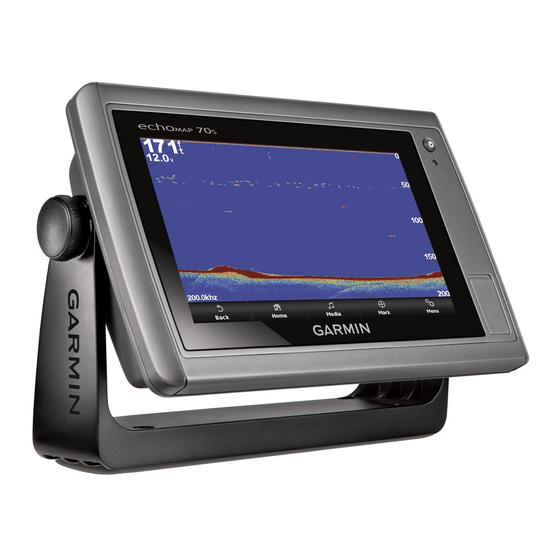2
Select an option:
• To set the top of the wind gauge to a North heading,
select North Up.
• To rotate the gauge so the direction in which you are
moving is at the top, select Head Up.
Configuring the Heading Source of the Environment
Gauge
You can specify the source of the heading displayed on the
environment gauge. Magnetic heading is the heading data
received from a heading sensor, and GPS heading is calculated
by your chartplotter GPS (course over ground).
1
Select Gauges > Environment > Menu > Heading Source.
2
Select GPS Hdg or Magnetic.
Setting the Barometer Reference Time
You can specify the reference time used to calculate the
barometer trend. The trend is indicated in the barometer field.
1
Select Gauges > Environment > Menu > Pressure Ref.
Time.
2
Select an option.
Tide, Current, and Celestial Information
Tide Station Information
You can view information about a tide station for a specific date
and time, including the tide height, and when the next high and
low tides will occur. By default, the chartplotter shows tide
information for the most recently viewed tide station and for the
present date and time.
Select Nav Info > Tides & Currents > Tides.
Current Station Information
NOTE: Current station information is available with certain
detailed maps.
You can view information about a current station for a specific
date and time, including the current speed and level of the
current. By default, the chartplotter shows current information
for the most recently viewed current station and for the present
date and time.
Select Nav Info > Tides & Currents > Currents.
Celestial Information
You can view information about sunrise, sunset, moonrise,
moonset, moon phase, and the approximate sky view location
of the sun and moon. The center of the screen represents the
sky overhead, and the outermost rings represent the horizon.
By default, the chartplotter shows celestial information for the
present date and time.
Select Nav Info > Tides & Currents > Celestial.
Viewing Tide Station, Current Station, or Celestial
Information for a Different Date
1
Select Nav Info > Tides & Currents.
2
Select Tides, Currents, or Celestial.
3
Select an option.
• To view information for a different date, select Change
Date > Manual, and enter a date.
• To view information for today, select Change Date >
Current.
• If available, to view information for the day after the date
shown, select Next Day.
• If available, to view information for the day before the date
shown, select Previous Day.
Digital Selective Calling
Viewing Information for a Different Tide or Current
Station
1
Select Nav Info > Tides & Currents.
2
Select Tides or Currents.
3
Select Nearby Stations.
4
Select a station.
Viewing Almanac Information from the Navigation
Chart
1
From a chart or 3D chart view, select a location.
2
Select Information.
3
Select Tides, Currents, or Celestial.
Digital Selective Calling
Networked Chartplotter and VHF Radio
Functionality
If you have a NMEA 0183 VHF radio or a NMEA 2000 VHF
radio connected to your chartplotter, these features are
enabled.
• The chartplotter can transfer your GPS position to your radio.
If your radio is capable, GPS position information is
transmitted with DSC calls.
• The chartplotter can receive digital selective calling (DSC)
distress and position information from the radio.
• The chartplotter can track the positions of vessels sending
position reports.
If you have a Garmin NMEA 2000 VHF radio connected to your
chartplotter, these features are also enabled.
• The chartplotter allows you to quickly set up and send
individual routine call details to your Garmin VHF radio.
• When you initiate a man-overboard distress call from your
radio, the chartplotter shows the man-overboard screen and
prompts you to navigate to the man-overboard point.
• When you initiate a man-overboard distress call from your
chartplotter, the radio shows the Distress Call page to initiate
a man-overboard distress call.
Turning On DSC
Select Settings > Other Vessels > DSC.
DSC List
The DSC list is a log of the most recent DSC calls and other
DSC contacts you have entered. The DSC list can contain up to
100 entries. The DSC list shows the most recent call from a
boat. If a second call is received from the same boat, it replaces
the first call in the call list.
Viewing the DSC List
Before you can view the DSC list, the chartplotter must be
connected to a VHF radio that supports DSC.
Select Nav Info > Other Vessels > DSC List.
Adding a DSC Contact
You can add a vessel to your DSC list. You can make calls to a
DSC contact from the chartplotter.
1
Select Nav Info > Other Vessels > DSC List > Add
Contact.
2
Enter the Maritime Mobile Service Identity (MMSI) of the
vessel.
3
Enter the name of the vessel.
23

